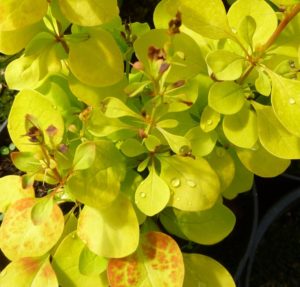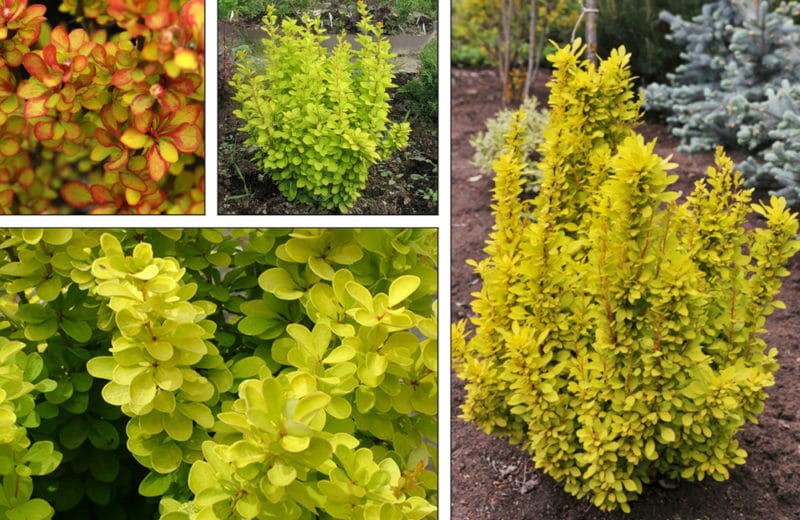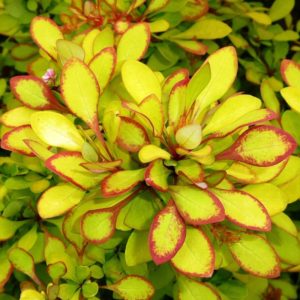Picturesque variety of barberry Maria for garden decoration
Barberry Maria is a stunningly beautiful ornamental shrub, bred by Polish breeders specifically for cultivation in the climatic conditions of Russia. The bushes are decorated with fruit clusters with scarlet berries that taste sweet and sour.
What kind of barberry variety is this: characteristics and description
Variety barberry Maria was created by Polish breeder Lucian Kurowski in 2001. To do this, he used the Aurea variety and the free pollination method.
Kurovsky set himself the task of creating a variety of culture that would organically fit into the climatic conditions of Russia.
 The variety, named after the breeder's wife and patented in 2005, took third place at the Plantarium exhibition in 2007 for its high decorativeness.
The variety, named after the breeder's wife and patented in 2005, took third place at the Plantarium exhibition in 2007 for its high decorativeness.
The shrub changes its decorative appearance throughout the season. The leaves are round and slightly oblong. In spring they are red, in summer they are yellow with carmine-red edges, and in autumn they turn orange-red.
In May, barberry Maria blooms profusely with yellow spherical fragrant flowers. The berries are oblong, scarlet, perfectly even, and ripen in October. The fruits are edible and have a pleasant sweet and sour taste.
The height of the bush is 1.5 m, and the diameter is 1 m. The Maria variety is a slow-growing type of barberry, reaching its final size at the age of 7 years.
The crown is spreading, thickened, columnar. Vertical shoots reach 1 m in height.
Reference. Barberry honey has a delicate, unique taste and a pleasant straw color.
Application in landscape design

Barberry Maria is used in landscape compositions. The variety is popular due to its excellent aesthetic qualities:
- foliage that changes color from season to season;
- medium sized shrub;
- neat crown;
- ease of pruning;
- opportunities to create a hedge;
- combination with conifers, flowers and other shrubs;
- framing border elements of a personal plot;
- zoning of individual areas;
- creating color blocks;
- planting in flower beds and lawns;
- mixborders from different varieties of barberry;
- design of rockeries and rock gardens;
- emphasis on discounts.
Pros and cons of the variety
Benefits of barberry Thunberg Maria:
- frost resistance;
- heat resistance;
- decorativeness;
- undemanding to the place of planting and care;
- use in landscape design;
- combinations with different types of plants;
- immunity to viruses and bacteria;
- honey flowers.
The disadvantage of the Maria variety is the shedding of leaves in conditions of moisture deficiency.
Growing technology
Maria barberry seedlings must be selected carefully. Experienced gardeners advise buying it in trusted centers. Evenly colored foliage, a smooth crown without damage, and a healthy rhizome indicate high-quality planting material. The seedling must have at least 3 branches up to 50 cm long.
Optimal conditions
Yellow barberry Maria is planted in sunlit areas or in partial shade without drafts. In shaded areas, the plant loses its decorative effect: the foliage fades and acquires an inexpressive green color. A prerequisite for successful cultivation of the Maria variety is soil drainage and prevention of water stagnation.
The shrub does not require much space to grow. Single bushes grow well on 1 m². To create a hedge, bushes are planted densely - every 50 cm.
Landing dates and rules
The optimal time for planting barberry is October - November. It is important to arrive before the first frost. In September, it is too early to carry out planting work, since the bushes will have time to sprout young shoots. Planting material planted in autumn develops intensively in the following seasons.
Before planting, the area is dug up, weeds are removed, and the soil is loosened. Add lime (300 g per 10 liters of water) or wood ash to acidic soil.
Before planting, inspect the root system. If the roots are dry, the seedling is immersed in water for 2-3 hours. When a seedling is purchased along with a container filled with fertile soil mixture, it is removed along with a lump of earth and moistened.
Landing algorithm:
- The depth and diameter of the hole for a single planting is 50x50x50 cm. If a hedge is planned, dig a trench. Additional depth is needed for drainage at the bottom, on top of which a mixture of sand, peat or wood ash (1:1) is placed, followed by humus.
- Pour a bucket of water into the hole and wait until the moisture is completely absorbed.
- The substrate is prepared from sand, turf, humus 1:1:1 and the hole is half filled with this mixture.
- The seedling is placed in the center of the hole, the hole is completely filled and the soil is compacted. A small hole is formed in the trunk area.
After the soil has settled, add it to the required level and mulch with sawdust or dry grass.
Further care
Barberry Maria does not like excess moisture. It is enough to water the tree trunk circle at the root once a week, without getting on the leaves.
Fertilizers applied during planting will last for a whole year.The next portion is added in the second year of the bush’s life. In spring, it is preferable to apply mineral fertilizers (potassium, magnesium) for better growth and brightness of foliage. In autumn, the plant is fed with organic matter.
Sanitary pruning of single bushes is carried out in spring and autumn; dry and damaged branches are removed after the first leaves appear.
When creating a hedge or forming a certain shape of a bush, pruning is carried out in June and August.
Possible problems, diseases, pests
The variety is resistant to fungal diseases, bacterial infections and pests, however, experts do not recommend neglecting regular inspection of the bushes, as well as preventive treatment with chemical and biological agents.
In unfavorable conditions (excessive humidity, stagnant water, planting in shaded areas), rust and powdery mildew may appear. In spring, treatment is carried out with copper-based products. In the event of a fungal infection, “Chorus”, “HOM”, “Fitosporin” are used.
The spread of aphids in the area leads to the loss of the decorative appearance of the plant, and in some cases, to its death. To destroy insect pests, fungicides “Karbofos”, “Kinmiks”, “Aktellik” are used. To prevent infection in the spring, bushes are treated with Bordeaux mixture.
Wintering
The Maria variety withstands frosts down to -25°C. Adult plants with powerful rhizomes do not need to be additionally covered for the winter, but young bushes are insulated with spruce branches, burlap, and agrofibre.
At the beginning of spring, the cover is removed to prevent the accumulation of condensation.
Features of cultivation depending on the region
Barberry Maria is suitable for growing in the middle zone, Moscow region, Leningrad region, as well as in the south of the country.
The algorithm for planting, propagation and care is the same for all regions.
Reproduction
To obtain planting material, seeds are used, cuttings are cut, or the bush is divided into several parts.
Seeds are collected from the fruits and sown in the ground in spring or autumn. Before autumn sowing, the area is plowed, furrows 3 cm deep are formed, the seeds are distributed and watered.
Stratified seeds are sown in spring. To do this, they are washed in clean water and then filled with a weak solution of potassium permanganate. Prepared seeds are sown in loose and moist soil to a depth of 1 cm.
The most popular method among gardeners is cuttings. Cuttings are taken from the mother 3-year-old bush in early summer. Each one must have at least 3 internodes. Planting material is buried in fertilized moist soil and covered with polyethylene. After the leaves appear, the shoots are planted in a permanent place.
Beginning gardeners often use the method of dividing a bush, considering it the simplest and most effective. The mother bush is dug up and the rhizome is divided into several parts, using a sharpened pruner.
Advice from experienced gardeners
Take note of the recommendations of experienced gardeners:
- Use only ripe, frost-touched barberry fruits for food. Greens can cause poisoning.

- Prepare juice, jam, marshmallows, sauces for meat from the fruits, and put the leaves in pickles and marinades.
- Plant the shrub in open sunny areas or in partial shade. The brightness of the foliage depends on the level of light: the more sun, the richer the color.
- The culture does not like stagnation of water and excess moisture. This leads to rotting of the root system. Plant the plant at higher elevations or make an earthen mound.
- The soil must be alkaline.Adjust pH by adding lime.
- If the soil on the site is clayey or too heavy, mix it with river sand.
- Place drainage at the bottom of the hole to prevent water stagnation.
- When planting, make sure that the root collar remains on the surface.
- Compact the soil after planting to avoid air pockets.
Conclusion
The barberry variety Maria was developed by Polish breeders. The crop is distinguished by high adaptive abilities: it is resistant to cold, heat, sharp fluctuations in average daily air temperature, it grows both on black soil and on soddy-podzolic soils, poor in nutrients. Ripe fruits can be eaten fresh, prepared into juices, jams, sauces for meat, and the leaves can be used for winter twists.